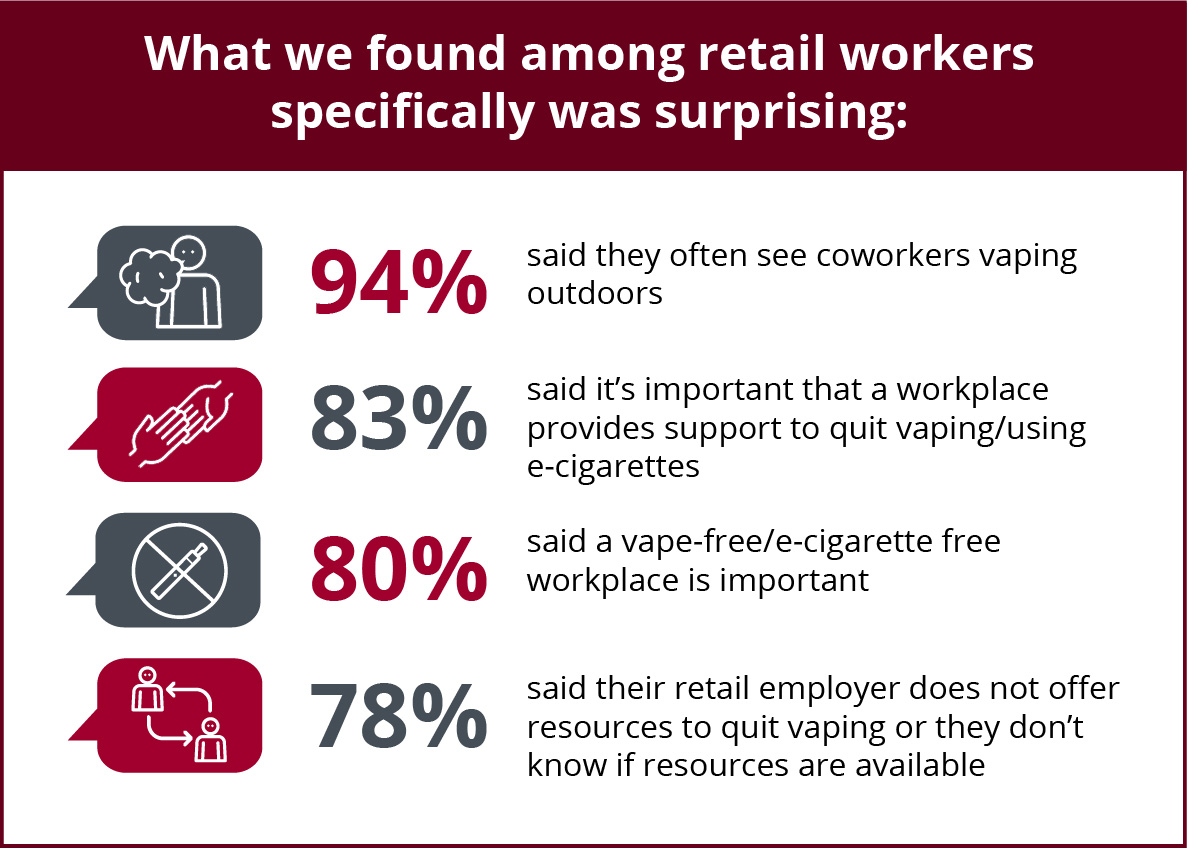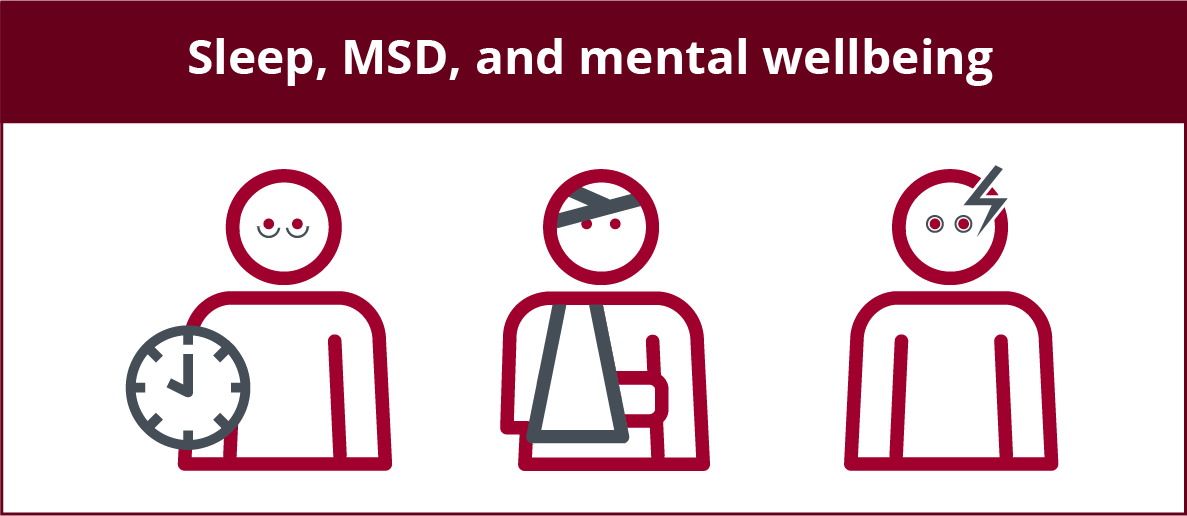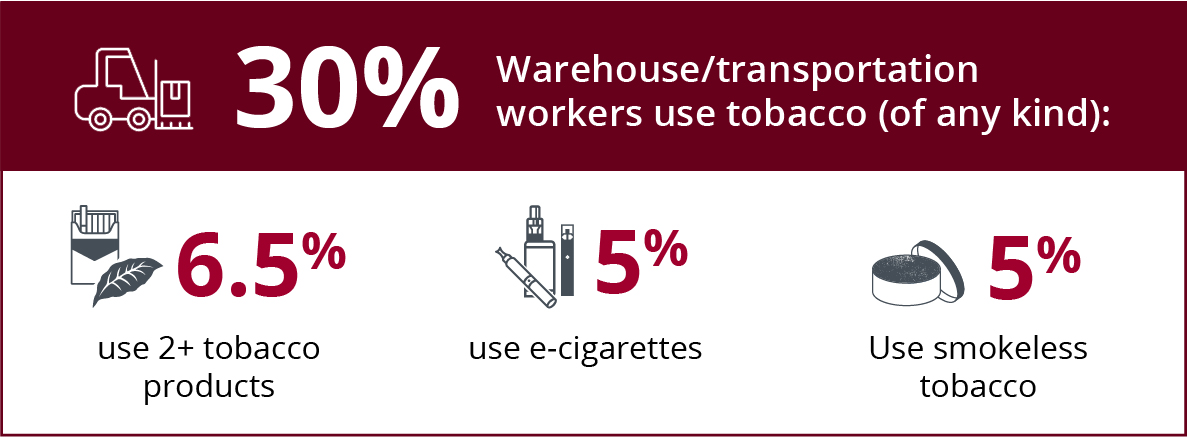In retail, 24% of employees use tobacco; that’s about 1 in 4 employees. But for some employers, this alone isn’t enough reason to offer employees a quit-smoking program.
Sound like your company? Well, timing is everything—and with trends and changes within the retail industry, now is the time to reconsider.
Here are 4 clues your retail organization needs a quit-smoking program pronto.
1 . Vaping is impacting your workplace.
We recently surveyed 1,620 U.S. employed adults from a range of industries and companies to ask about their experience with vaping in the workplace.
To be clear, vaping isn’t harmless, either for e-cigarette users themselves or for those exposed to secondhand aerosol. To learn more about vaping in the workplace, download “5 Things Employers Need to Know Now about E-cigarettes.”
2. Sleep, MSD, and mental wellbeing are common health issues for your employees.
If you, like many other retailers, are focused on addressing sleep, musculoskeletal disorders (MSD), and mental health in 2020 and beyond, addressing tobacco use is a must.
- Retail tops the list of industries for work-related stress. Job insecurity and low-wage living associated with working retail contribute to this stress, and tobacco use is often used as a coping strategy.
- Retail has a high incidence of MSD, such as back injuries, sprains, or strains. Repetitive motion disorders such as carpal tunnel syndrome and injuries resulting from overexertion are also common for retail workers. Smoking worsens MSD issues, for example, by weakening bones and tissue around the joints.
- Retail workers typically work long hours and varied schedules, which affect sleep. Retail workers who use tobacco face additional sleep issues due to nicotine, which can impact sleep even more than caffeine or alcohol. In turn, these poor sleep patterns increase a person’s risk of costly chronic conditions.
3. Your workforce tends to be younger.
Different age groups tend to use different tobacco products. E-cigarette use, for example, is higher among those ages 18-24 compared to other age groups—and that usage is growing. Nearly all e-cigarettes contain nicotine, which can make workers more vulnerable to smoking. Young people who use e-cigarettes and weren’t smokers in the first place are 4X more likely to start smoking traditional cigarettes than their peers who don’t vape.
Additionally, many retail employees start in entry-level positions in their teens or early 20s and take on supervisory, management, and leadership positions as their careers progress. As workers move up the career ladder, they take their tobacco use with them.
Every tobacco user in your organization costs you nearly $6,000 each year. Offering a quit-smoking program to help employees quit—earlier than later—benefits your organization.
5. Your business is shifting and expanding to online retail.
While brick-and-mortar retail stores still play a key role in the sales process, many retailers are expanding to online as part of a broader retail strategy. Take retail giant Marshalls, for example. In 2019, Marshalls opened its first online store, resulting in warehouse and transportation workers becoming even more prevalent members of the workforce.
However, among warehouse and transportation workers, tobacco use (30%) is even higher than retail, making a quit-smoking program even more critical.
Right-fit solution for a quit-smoking program
To effectively help tobacco users quit, providing an evidence-based tobacco cessation program is must-have. For retailers, in addition to using a clinically proven solution, we recommend you look for a program that meets the specific needs of your workforce by offering:
- Easily accessible tools. This includes live chat coaching with tobacco treatment experts that workers can use while on breaks for answers to questions about cravings, quit medication and more; text message support before or after a shift, a thriving online community of peers available 24/7; and free quit medication delivered right to their home.
- Tailored support for all forms of tobacco use, including smoking, vaping, and chew.
- Multimodal tools that appeal to a wide range of worker demographics.
The EX Program delivers all of this and more. To see how we can better meet the unique needs of your retail workforce, contact us today.
For more information about the impact of tobacco on retail workers, see our blogs Care About Employee Mental Health? This Matters Too and .4 Ways Tobacco Use Makes Musculoskeletal Disorders More Costly








